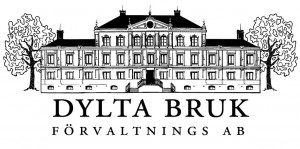Cultural Environment
Dylta Bruk has a buildings environment that is classified as being of national historical interest. The present owner is eager to take care of his cultural inheritance, which in addition to the buildings environment contains historical and cultural traditions linked to the Manor House, which has formed a natural centre in the cultural life of the community.
The Manor House
The cellar of the Manor House dates back to 1575. The main building, which is built in wood, dates from the 1740s. The well-known architect Johan Fredrik Åbom was commissioned in the 1850s, and he designed the Manor House as a large almost palace-like complex with the buildings strictly grouped around a central axis leading through two courtyards out into the park.
The main building was enlarged and, like the wings that were added later, was built in the late Classical style that it now has. The building project, the largest that Dylta has ever seen, was managed by August Nyström from Hållingstorp, Östergötland, who was an old, eminent colleague of Johan Fredrik Åbom. Nyström and his brother Johan Robert, two of the most respected and widely-employed master builders of palace and church buildings of the time, also built the wings to the Manor House.
Around this stately central point, we can see a wide range of farm buildings and outhouses, as well as administrators’ and labourers’ dwellings. The buildings mainly date from the 18th and 19th centuries. Many are monumental in their style.
The older buildings worthy of special note include the so-called Monastery, which originally was probably a storehouse from the 1500s (it is now a works and farm museum). There is a unique legend surrounding this building, concerning the flight in 1576 of Johan III and Katarina Jagellonica from the plague to Dylta sulphur mill, which was then a royal demesne. We may wonder how the legend arose, since the sulphur mill did not exist until 1582.
From this time onwards, the Bruk had its own priest and during the period 1688-1818 was a separate parish. The bell-tower built in 1714 remains from this period, and the cemetery established in 1712 is still in use.
Industrial heritage
Dylta Bruk is a well-preserved and unique industrial environment with roots in the 16th century, where the passage of time can clearly be perceived. The adjacent Manor House with its farm buildings reinforces the impression of an industrial production deeply rooted in Swedish tradition.
Many buildings and installations bear witness to an earlier, almost 400-year period as a mill. Sulphur was produced on an industrial scale as early as 1583. The production was later supplemented with vitriol, alum and red paint.
The manufacture of Dylta red paint began as long ago as 1586 (164 years before Falu Rödfärg began) and continued up until 1941.
The sulphur quarry, buildings for the production of red paint, the washery and waste tips still remain, and are part of the Industrial Museum located at the site. The Industrial Museum is an attractive destination for tourists.
Contact the Estate Office on 019-22 20 00 for further information.

The bell-tower built in 1714

The Dairy

The red paint mill
